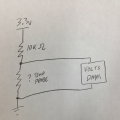Mystery temp probe from Parallax Meet-up junk Bin
Recognize this device?
I picked up a couple of these either during the Summer 2013 meet-ups or prior Propeller events, not sure. I have finally got to the project that I planned use of the device.
The mystery is, what are the specs? It is fully environmentally sealed, haven't attempted to peal off - doubt any clues would surface without damaging it anyway. It has an 8 pin Molex connector with each sensor having its own pair of pins. Several sensors at different lengths from the connector are bundled together with zip ties. This appears to be setup for a data center rack monitoring system - just a guess.
I setup a simple voltage divider with 10K resister off of a 3.3v and the probe between that and ground. Reading the voltage across the temp probe.

My voltage reference is from a DMM (only have 1 good one, switching from temp to V). High temp is in front of a forced air heater, low temp is shop room temp. Observed that switching between high and low, the mystery device is very responsive.

I have 3 methods queued up for measuring the temp, two analog devices (this device, the other a LM34) and a digital (DS18B20). This is all about experimenting with different sensors and learning, NO commercial product at then end of this adventure.
Thanks for the feedback!
I picked up a couple of these either during the Summer 2013 meet-ups or prior Propeller events, not sure. I have finally got to the project that I planned use of the device.
The mystery is, what are the specs? It is fully environmentally sealed, haven't attempted to peal off - doubt any clues would surface without damaging it anyway. It has an 8 pin Molex connector with each sensor having its own pair of pins. Several sensors at different lengths from the connector are bundled together with zip ties. This appears to be setup for a data center rack monitoring system - just a guess.
I setup a simple voltage divider with 10K resister off of a 3.3v and the probe between that and ground. Reading the voltage across the temp probe.

My voltage reference is from a DMM (only have 1 good one, switching from temp to V). High temp is in front of a forced air heater, low temp is shop room temp. Observed that switching between high and low, the mystery device is very responsive.
TEMP / voltage across probe 90.5'F / 1.456V 62.2 'F / 1.881V

I have 3 methods queued up for measuring the temp, two analog devices (this device, the other a LM34) and a digital (DS18B20). This is all about experimenting with different sensors and learning, NO commercial product at then end of this adventure.
Thanks for the feedback!


Comments
In addition to the voltage changing, does the resistance change too?
Are there any markings on them?
No markings except MOLEX on the connector.
They told me Boiling water, and Ice water.
I found out that my digital probe was off, the icewater only got down to 1 C. Or maybe the mug was not insulated well enough. I have to redo the tests tonight.
This is all I got, unfortunately its all in forth. It might be worth a look anyway.
https://code.google.com/p/propforth/wiki/ThermistorTempSensor
https://propforth.googlecode.com/files/ThermistorRawLogger.f
https://propforth.googlecode.com/files/thermistor.f
I'm collecting the values for several temperatures, (boilg, freezing, ambient) then trying Steinhart-hart.
Next my math guy is running the same data through linear equations to see which works better.
I'm using the cheapest thermistors from Thailand, so even in the same batch they are all over the place. But I should be able to calibrate individual parts. They won't get swapped once they are in the final circuit.
That's what I am missing, a math guy. :cool:
I was thinking about waiting until my China parts show up that are digital (ebay). However based on your post you have motivated me to test these more. Thanks for the advice.
My fluke DMM measures to tenths, I should be able to get decent table of known values.
Perhaps a customer is who added these to the junk bin at a meet up. Don't know why I think that, can't remember when I got them.
The Steinhart-Hart spread sheet is kind of a mess but it works. All you need are the three temperatures and the asscoicated readings, and you can graph the curve or make a table of the temp to R-count value. I should be posting the that shortly.
If I get the linear equations I will put those ou too, but it might be a couple days.
Thanks Andrew! I knew it was from a customer, that was a while back, wow. Back at that expo were you showing off an LCD project?